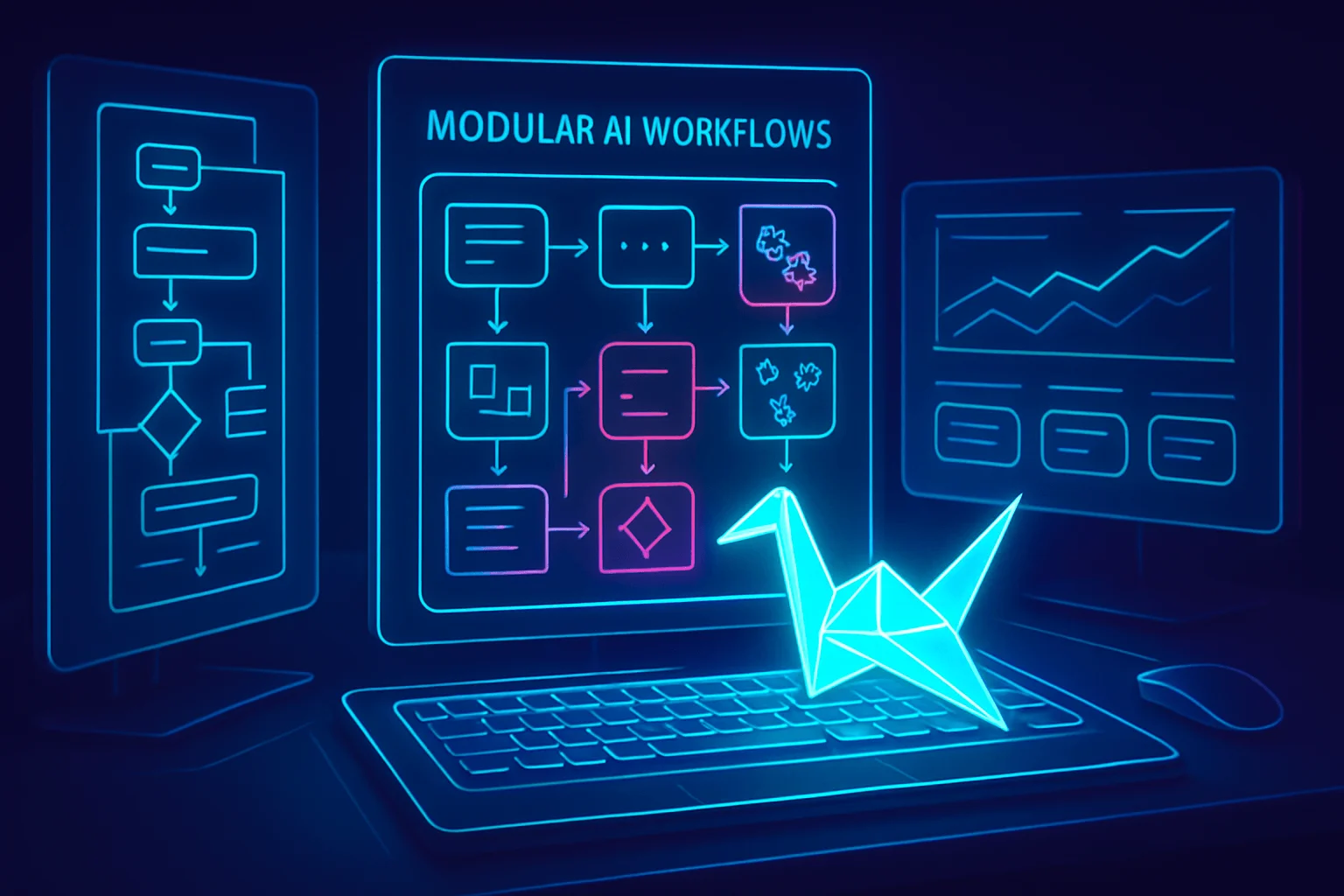How to Use No-Code AI Tools to Simplify and Automate Your Workflow

Picture this: your team spends hours each week on repetitive tasks—manually sending emails, copying data between spreadsheets, handling customer inquiries one by one. What if you could reclaim that time and redirect your talent toward innovation and growth? Thanks to the rise of no-code AI tools, this scenario is now within reach for businesses of any size or technical expertise. In today’s rapidly changing landscape, simplifying and automating everyday operations isn’t just a competitive edge—it’s a necessity for sustainable productivity. This guide takes you step-by-step through harnessing no-code AI to ease your workflow, from identifying ideal automation opportunities to setting up user-friendly tools without writing a single line of code. Whether you’re a solo entrepreneur or part of a growing enterprise, you’ll discover practical strategies, real-world examples, and essential best practices to transform how you work and free up resources to focus on what matters most.
Who is This For?
- Small business owners with limited technical expertise
- Freelancers and solopreneurs seeking productivity boosts
- Managers or team leaders in marketing, HR, or operations
- Employees wanting to automate repetitive or manual tasks
- Anyone curious about leveraging AI without learning to code
No-code AI automation tools democratize access to powerful technologies once reserved for tech-savvy programmers. If you ever wished routine tasks could handle themselves — like sorting emails, collecting leads, prepping reports, or compiling data — but hesitated at the thought of programming, this guide was written with you in mind. No-code tools allow you to build smart, automated workflows using intuitive visual interfaces. Whether you manage a small team, run a one-person operation, or simply want to impress your organization with new efficiency hacks, no-code AI can help you eliminate dull, manual work and reclaim valuable time for creative or high-impact activities.
Actionable Takeaway:
If you spend more than 2 hours each week repeating the same digital tasks, it’s time to explore no-code automation.
5 Steps to Get Started with No-Code AI Automation
1. Identify Repetitive or Time-Consuming Tasks
The first step in leveraging no-code AI automation is to take inventory: What tasks do you or your team do often that follow a predictable pattern? These are prime candidates for automation.
Tip: Make a list over a week of everything you do more than once, especially tasks involving copying-pasting, sorting, or responding to information.
Practical Scenario:
You run a small e-commerce site. Every day, you manually check your store for new orders, copy customer details into a spreadsheet, and send out shipping confirmation emails. These repetitive interactions steal focused time and mental energy.
Once your list is made, group tasks by type (e.g., data entry, communication, reporting). Start with something small but impactful — ideally a task that, if automated, would free up immediate time or reduce error risk.
Actionable Takeaway:
Pinpoint one task this week that makes you sigh or groan when it pops up.
2. Choose the Right No-Code AI Platform
With your main task in mind, select a no-code automation tool that aligns with your needs and integrates with your existing apps (e.g., email, spreadsheets, CRMs).
Tip: Consider platforms like Zapier (for workflow connections), Make (formerly Integromat), or Microsoft Power Automate if you’re invested in the Microsoft ecosystem. Check for free tiers or trial periods to start risk-free.
Practical Scenario:
A freelance marketer needs to auto-save email attachments to Google Drive and log their info in an Airtable base. Zapier offers pre-built templates for Gmail and Google Drive integrations, while Make provides visual mapping for more complex data steps.
Evaluate platforms on:
- Ease of use: Drag-and-drop interfaces, clear documentation
- Integration support: Major apps your business uses (Gmail, Slack, Shopify, Stripe, etc.)
- Built-in AI features: Features like email summarization, document scanning, chatbots, or smart data matching.
Test-drive a couple before committing, and don’t hesitate to ask support or community forums for recommendations for your use case.
Actionable Takeaway:
Sign up for a free trial of one no-code AI platform and explore its template library for inspiration.
3. Build Your First Automated Workflow
Once you’ve chosen a tool, it’s time to design your first automated workflow (commonly known as a “zap,” “scenario,” or “automation”).
Tip: Start with a simple, single-trigger workflow (e.g., “When a new row is added in Google Sheets, send a Slack message.”) Expand as you gain confidence.
Practical Scenario:
An HR manager wants to automate candidate screening emails. She sets up a Make scenario: When a new CV file lands in a designated folder, an AI writing assistant reviews for keywords, then auto-sends a friendly acknowledgment email.
Follow these steps:
- Define the trigger: The event that starts the automation (e.g., new email, new entry in spreadsheet).
- Set up AI actions: If your platform allows, integrate built-in AI features like sentiment analysis or auto-tagging.
- Add follow-up steps: These tasks follow the trigger (e.g., updating a record, sending an email, analyzing content).
Test thoroughly — use the platform’s built-in testing tools to ensure data flows as expected. Adjust as needed for best results.
Actionable Takeaway:
Build and test your first end-to-end automation on a non-essential process to build confidence and skills.
4. Integrate AI Features for Enhanced Intelligence
No-code platforms often include direct access to AI capabilities without the need to understand machine learning. Bringing in AI means your automation isn’t just faster — it’s smarter.
Tip: Look for features like auto-categorization, image or document recognition, language translation, or summarization. Experiment with one to see how it adds value.
Practical Scenario:
A content manager receives dozens of press releases weekly. By using an AI-driven automation, the tool scans and summarizes each press release and highlights the most newsworthy passages, neatly saving summaries to a shared document for the editorial team.
Explore:
- AI email summarization: Distills long emails into bite-sized updates.
- Document classification: Sorts files into predefined folders based on content.
- Chatbot integration: Handles common customer support questions via website chat.
Apply AI to bottlenecks where decision fatigue or information overload is common. Not every workflow needs AI, but the right use case can multiply your productivity gains.
Actionable Takeaway:
Bolster one workflow this month with an AI-powered action, such as auto-summarization or smart tagging.
5. Monitor, Optimize, and Scale Up Automation
Automation isn’t “set it and forget it.” Regularly review your automated workflows to ensure they continue to support your objectives. Look for new opportunities to expand.
Tip: Set weekly reminders to review automation logs and set up error notifications. Make use of analytics dashboards many tools provide.
Practical Scenario:
A real estate agency automates the intake of property listing leads. After two weeks, they notice some poorly formatted data. By tweaking the AI document parser and adding validation steps, they enhance data quality and prevent future issues.
Strategies:
- Monitor performance: Use integrated dashboards to review automation triggers, errors, or failed tasks.
- Solicit feedback: Ask your team where newly automated processes are helping or causing friction.
- Iterate and expand: Gradually add more steps, AI features, or new automated processes as your comfort grows.
Also keep an eye on updates from your chosen platforms; new integrations and AI features are released often.
Actionable Takeaway:
Establish a 30-minute monthly review routine to refine existing automations and brainstorm the next opportunity.
Recommended Resources
Here are some trusted tools and guidance to deepen your journey into no-code AI:
| Name | Type | Link | Benefit |
|---|---|---|---|
| Zapier | Automation | zapier.com | Easy, expansive app integrations; user-friendly |
| Make (Integromat) | Automation | make.com | Visual, modular scenarios; strong for power users |
| OpenAI GPT Integrations | AI/NLP | openai.com | Natural language processing & AI text functionality |
| Airtable | Database | airtable.com | No-code database, blends spreadsheet & database |
| Pipedream | Automation/API | pipedream.com | Developer-focused workflows, robust free tier |
Explanations:
- Zapier and Make are beginner-friendly platforms offering drag-and-drop workflow builders.
- OpenAI GPT Integrations allow access to advanced AI-powered text summaries, chatbots, and more.
- Airtable helps create structured, automated data hubs for inventory, leads, content, and beyond.
- Pipedream is valuable for tech-savvy teams wanting deeper custom API hooks, without full coding.
- NoCode.ai serves as a comprehensive educational hub for continuous upskilling.
Actionable Takeaway:
Bookmark and subscribe to updates from key platforms to stay informed about new features and best practices.
FAQs
1. Can no-code AI automations replace human jobs?
No-code AI automation is best viewed as a tool to augment human capabilities, not as a wholesale replacement. It can relieve teams of low-value, repetitive work — such as sorting emails, moving files, or copying data — freeing staff for more creative, customer-facing, or complex decision-making roles. Businesses that automate monotonous tasks often see job satisfaction improve, since employees spend more time on work they find meaningful.
Practical advice:
Instead of automating “everything,” ask, “What tasks bore my team, and which require uniquely human judgment?” Start automating just the tedious ones.
2. How do I handle mistakes or failures in automated workflows?
Automated processes can break if apps change, data is inconsistent, or rules aren’t defined clearly. Most modern platforms provide detailed error logs and instant notifications when something goes wrong. To ensure reliability:
- Test each automation thoroughly before using it with live data.
- Set up alert notifications for failures.
- Always keep a manual alternative, especially for mission-critical operations.
- Start small and scale up, adding complexity only when early results are solid.
Practical advice:
Schedule periodic reviews (weekly or monthly) to check logs, tweak rules, and adapt to app updates or evolving business processes.
3. What are some creative but practical use cases for no-code AI automation in small businesses?
- Real-time customer support: Trigger AI chatbots to answer basic questions instantly on your website, freeing your team for high-touch inquiries.
- Automatic lead qualification: Use AI to read new sales leads’ emails or form submissions, prioritize them by urgency or interest, and schedule meetings.
- Smart content curation: Automatically scan industry news, summarize key findings, and email a daily digest to your team.
- Invoice and receipt processing: Extract key data from invoices as PDFs or emails, categorize in your accounting app, and flag any anomalies via Slack.
- Employee onboarding: When a new person joins, automate welcome emails, resource list delivery, and reminders for HR to complete setup steps.
Practical advice:
Choose one customer-facing and one internal workflow to automate early on, measuring the time saved and gathering user feedback.
Final Actionable Takeaway:
No-code AI automation isn’t just about working faster — it’s about working smarter, consistently freeing teams from digital drudgery and unleashing creativity across your business. Start small, learn as you go, and watch as everyday operations become easier, leaner, and more productive.
Stepping into the world of no-code AI automation is no longer reserved for tech experts—it’s now an accessible, practical path for any business professional looking to save time and operate smarter. By identifying routine tasks, exploring intuitive platforms, and following quick-start examples, we’ve seen how even beginners can introduce AI-powered solutions into daily operations with confidence. In today’s rapidly evolving digital landscape, adopting these tools isn’t just a competitive edge—it’s quickly becoming essential. Take a moment to reflect on where automation could remove bottlenecks in your own workflow, and don’t hesitate to experiment with recommended no-code platforms. If you’ve tried a tool mentioned here or have insights to share, drop a comment below! Let’s continue learning, streamlining, and thriving—together. Remember, the journey doesn’t stop at your first automated workflow. As your familiarity with no-code AI platforms grows, new possibilities will naturally reveal themselves. Start by mapping your daily processes: Where do repetitive data entries, email sorting, or customer inquiries slow you down? Many of these tasks are prime candidates for automation—with user-friendly drag-and-drop interfaces, you can connect tools you already use, like spreadsheets, CRMs, or web forms, in just minutes.
Leverage resources offered by the no-code community—forums, tutorials, webinars, and case studies abound, providing guidance tailored to every industry and skill level. Many platforms even feature template libraries, so you can implement proven automations with a single click and customize as needed. Don’t overlook the value of experimentation: test small, measure results, and iterate. Results like faster turnaround times, fewer manual errors, and more satisfied customers often follow quickly.
As your confidence builds, branch out to more complex automations. Integrate AI-powered chatbots to handle frequently asked questions, set up tools that analyze and categorize feedback, or schedule reports that update automatically. Not only does this free up your time for more creative, value-added work, but it also showcases your initiative and adaptability—essential qualities in today’s workforce.
Ultimately, adopting no-code AI automation is about empowering yourself. It puts sophisticated technical capabilities within reach, allowing you to proactively shape better ways of working—regardless of your programming background. So stay curious, keep exploring, and celebrate each small win along the way. The landscape is evolving, and your journey is just beginning—one automated task at a time.



